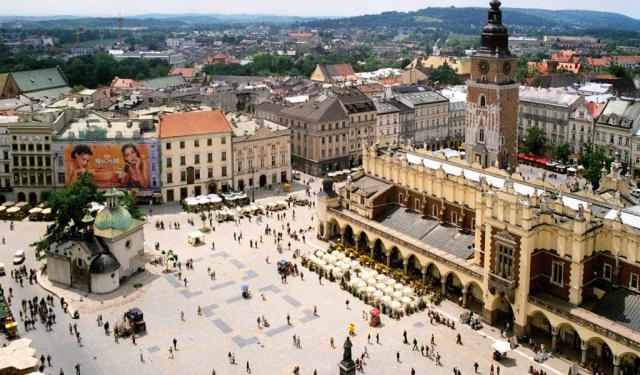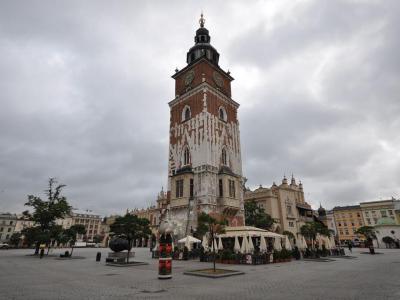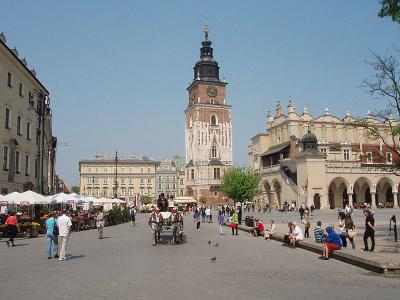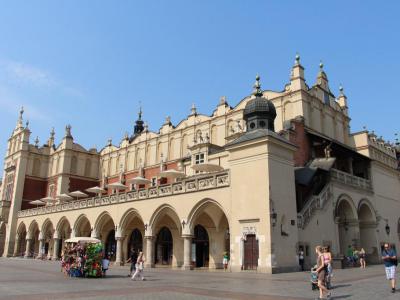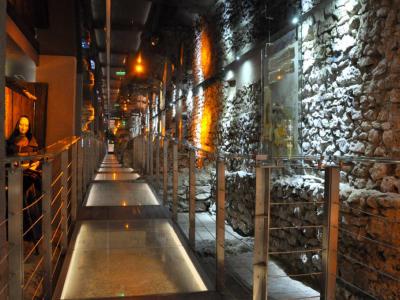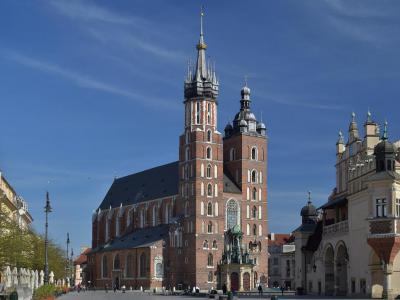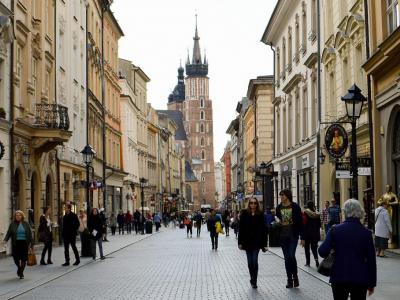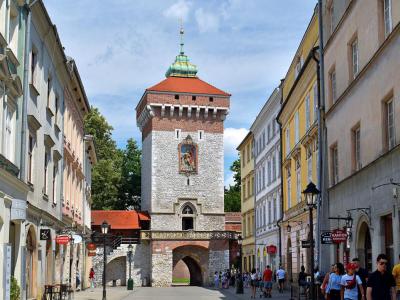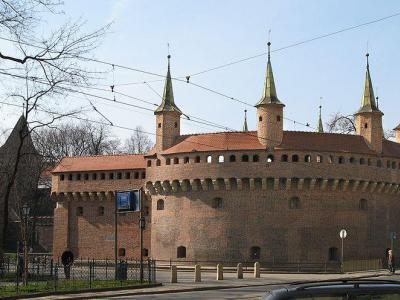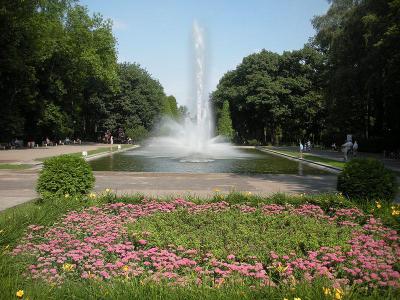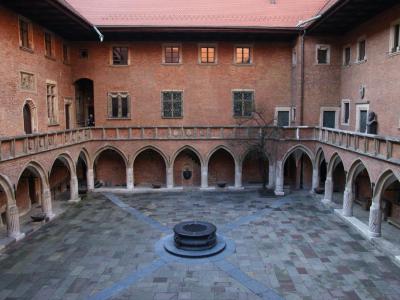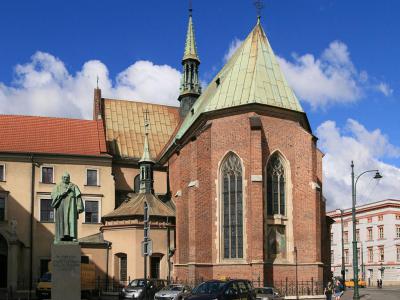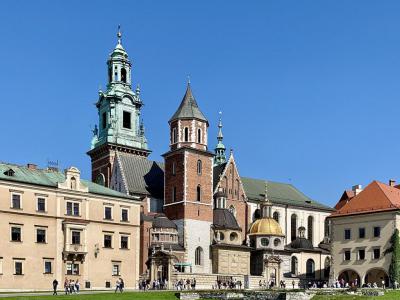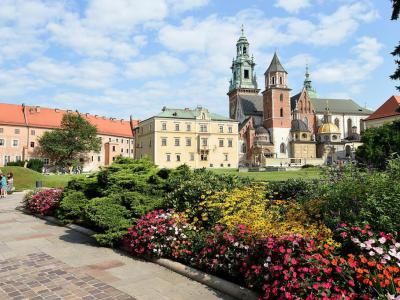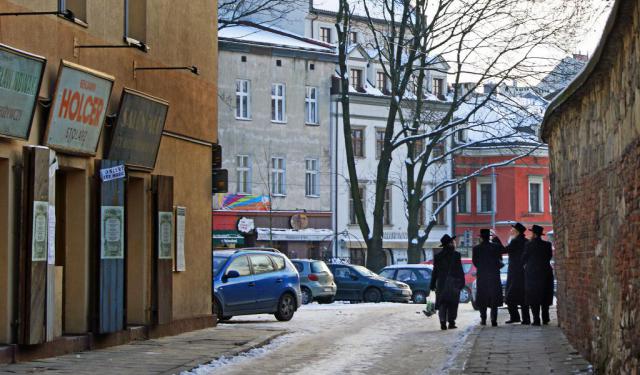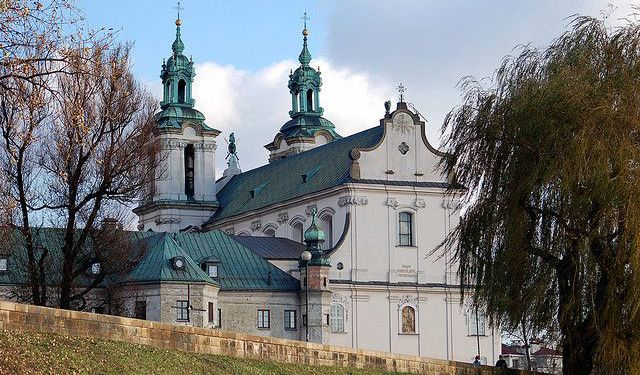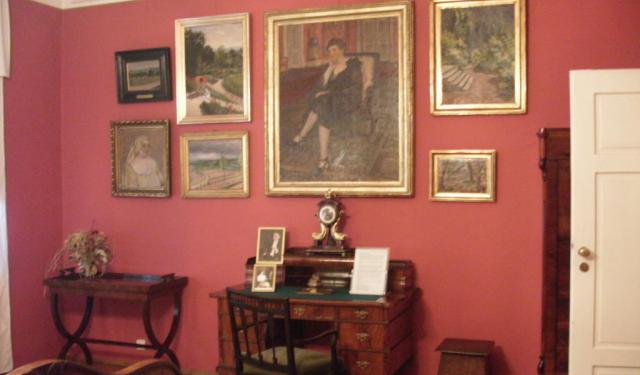Krakow Introduction Walking Tour (Self Guided), Krakow
A unique entry on the list of the World Heritage Sights, Krakow is a recognized center of the academic, artistic and cultural life of Poland. Established in the 7th century as a tiny hamlet at the top of the Wawel Hill, overlooking the Vistula River, it is one of the country's oldest cities. Over the course of the next fifteen centuries it has evolved into the nation's second-largest urban area.
Its full official name – Stołeczne Królewskie Miasto Kraków – translates as the "Royal Capital City of Kraków", and is traditionally attributed to Krakus (Krak, Grakch), the legendary founder of the city and a ruler of the tribe of Lechitians. Therefore, Krakow essentially means "Krak's (town)".
By 965 Krakow had emerged as a busy trading center of Central Europe and, up until 1596, served as the official capital of Poland. With the establishment of new universities and cultural venues at the dawn of the Second Polish Republic in 1918, the city reaffirmed its role as a major national academic and artistic hub.
After the invasion of Poland by Nazi Germany during World War II, the Jewish population of Krakow was forced into a ghetto and then exterminated, most of, in gas chambers. The city itself was spared from major bombing and was ultimately saved from total destruction by the Nazis – who wanted to blow it up – by the Soviets.
In 1978 Krakow gained fame through its former archbishop, Karol Wojtyła, who became Pope John Paul II - the first non-Italian pope in 455 years.
Today's Krakow is one of Europe's most beautiful and culturally richest tourist destinations, renowned, primarily, for its Old Town – the first ever UNESCO World Heritage Site! The city's medieval core – ringed by Planty Park and remnants of the ancient walls – is undoubtedly the best place to start your acquaintance with Krakow. A must-see attraction here is the expansive Rynek Glówny (“Main Market”) square complete with the Renaissance-era Cloth Hall and the 14th-century St. Mary’s Basilica. If you're an architecture buff, you wouldn't want to miss other Gothic, Renaissance and Baroque jewels, such as the Wawel Cathedral and Royal Castle, and the Collegium Maius – home to Jagiellonian University, one of the oldest in the world.
To explore these and other popular sights in Krakow at your own pace, take this self-guided orientation walk.
Its full official name – Stołeczne Królewskie Miasto Kraków – translates as the "Royal Capital City of Kraków", and is traditionally attributed to Krakus (Krak, Grakch), the legendary founder of the city and a ruler of the tribe of Lechitians. Therefore, Krakow essentially means "Krak's (town)".
By 965 Krakow had emerged as a busy trading center of Central Europe and, up until 1596, served as the official capital of Poland. With the establishment of new universities and cultural venues at the dawn of the Second Polish Republic in 1918, the city reaffirmed its role as a major national academic and artistic hub.
After the invasion of Poland by Nazi Germany during World War II, the Jewish population of Krakow was forced into a ghetto and then exterminated, most of, in gas chambers. The city itself was spared from major bombing and was ultimately saved from total destruction by the Nazis – who wanted to blow it up – by the Soviets.
In 1978 Krakow gained fame through its former archbishop, Karol Wojtyła, who became Pope John Paul II - the first non-Italian pope in 455 years.
Today's Krakow is one of Europe's most beautiful and culturally richest tourist destinations, renowned, primarily, for its Old Town – the first ever UNESCO World Heritage Site! The city's medieval core – ringed by Planty Park and remnants of the ancient walls – is undoubtedly the best place to start your acquaintance with Krakow. A must-see attraction here is the expansive Rynek Glówny (“Main Market”) square complete with the Renaissance-era Cloth Hall and the 14th-century St. Mary’s Basilica. If you're an architecture buff, you wouldn't want to miss other Gothic, Renaissance and Baroque jewels, such as the Wawel Cathedral and Royal Castle, and the Collegium Maius – home to Jagiellonian University, one of the oldest in the world.
To explore these and other popular sights in Krakow at your own pace, take this self-guided orientation walk.
How it works: Download the app "GPSmyCity: Walks in 1K+ Cities" from Apple App Store or Google Play Store to your mobile phone or tablet. The app turns your mobile device into a personal tour guide and its built-in GPS navigation functions guide you from one tour stop to next. The app works offline, so no data plan is needed when traveling abroad.
Krakow Introduction Walking Tour Map
Guide Name: Krakow Introduction Walking Tour
Guide Location: Poland » Krakow (See other walking tours in Krakow)
Guide Type: Self-guided Walking Tour (Sightseeing)
# of Attractions: 13
Tour Duration: 2 Hour(s)
Travel Distance: 3.3 Km or 2.1 Miles
Author: ellen
Sight(s) Featured in This Guide:
Guide Location: Poland » Krakow (See other walking tours in Krakow)
Guide Type: Self-guided Walking Tour (Sightseeing)
# of Attractions: 13
Tour Duration: 2 Hour(s)
Travel Distance: 3.3 Km or 2.1 Miles
Author: ellen
Sight(s) Featured in This Guide:
- Town Hall Tower
- Rynek Główny (Main Square)
- Sukiennice (Cloth Hall)
- Underground Main Square Museum
- Basilica of St. Mary
- Florianska Street
- St. Florian's Gate Tower
- The Barbican (Barbakan)
- Planty Park
- Collegium Maius (Great College)
- Basilica of St. Francis
- Wawel Cathedral
- Wawel Royal Castle
1) Town Hall Tower
The Town Hall Tower is one of the most distinctive landmarks on Kraków’s Main Market Square. Built in the late 13th century and reconstructed several times over the centuries, it originally formed part of Kraków’s grand Town Hall complex, which once dominated the eastern side of the square. While the rest of the Town Hall was demolished in the early 19th century during a wave of urban modernization, the tower survived and became an enduring symbol of the city’s historic heart.
Constructed from stone and brick, the tower leans slightly—about 55 centimeters—due to a powerful storm in 1703 that shifted its foundations. Its Gothic architecture is softened by later Baroque additions, including an ornate entrance portal and decorative interior details. One of its most prominent features is its elegant spire, which has been replaced more than once throughout history. Despite its refined appearance, the tower also housed a prison with torture chambers, reflecting the dual civic and judicial roles of medieval town halls.
Today, visitors can climb the tower’s narrow staircase to reach an upper viewing platform. The effort is rewarded with sweeping views over the Main Market Square, St. Mary’s Basilica, the Cloth Hall, and the tight medieval street grid that radiates from the city center. Along the ascent, small displays recount the tower’s history and offer insight into Kraków’s system of urban governance.
At the base of the tower, a stone lion and lioness flank the entrance—neo-Gothic sculptures added in the 19th century—symbolizing civic pride and strength.
Constructed from stone and brick, the tower leans slightly—about 55 centimeters—due to a powerful storm in 1703 that shifted its foundations. Its Gothic architecture is softened by later Baroque additions, including an ornate entrance portal and decorative interior details. One of its most prominent features is its elegant spire, which has been replaced more than once throughout history. Despite its refined appearance, the tower also housed a prison with torture chambers, reflecting the dual civic and judicial roles of medieval town halls.
Today, visitors can climb the tower’s narrow staircase to reach an upper viewing platform. The effort is rewarded with sweeping views over the Main Market Square, St. Mary’s Basilica, the Cloth Hall, and the tight medieval street grid that radiates from the city center. Along the ascent, small displays recount the tower’s history and offer insight into Kraków’s system of urban governance.
At the base of the tower, a stone lion and lioness flank the entrance—neo-Gothic sculptures added in the 19th century—symbolizing civic pride and strength.
2) Rynek Główny (Main Square) (must see)
Kraków’s Main Square is the largest medieval square in Europe, serving as the vibrant heart of the city for more than 750 years. Covering nearly 40,000 square meters, it was laid out in 1257 after the Mongol invasion, when Kraków was rebuilt according to a new urban plan that emphasized order, trade, and civic life. The square quickly became the centre of commerce and public events, surrounded by merchant houses, noble residences, and key municipal buildings. Over the centuries, it has witnessed royal ceremonies, markets, festivals, uprisings—everything under the sun.
At the center of the square stands the Cloth Hall, a Renaissance trading hall that once formed part of the city’s major commercial network. Today, it houses craft stalls on the ground floor and an art gallery upstairs, continuing its tradition as a marketplace. Nearby rises the iconic St. Mary’s Basilica, distinguished by its two asymmetrical towers.
Elegant palaces line the perimeter, many now home to museums, cafés, and restaurants. Beneath the square, the Rynek Underground Museum reveals archaeological traces of medieval market stalls, roads, and merchant activity, immersing visitors in the city’s early urban history.
At the center of the square stands the Cloth Hall, a Renaissance trading hall that once formed part of the city’s major commercial network. Today, it houses craft stalls on the ground floor and an art gallery upstairs, continuing its tradition as a marketplace. Nearby rises the iconic St. Mary’s Basilica, distinguished by its two asymmetrical towers.
Elegant palaces line the perimeter, many now home to museums, cafés, and restaurants. Beneath the square, the Rynek Underground Museum reveals archaeological traces of medieval market stalls, roads, and merchant activity, immersing visitors in the city’s early urban history.
3) Sukiennice (Cloth Hall) (must see)
The Cloth Hall is a masterpiece of Renaissance architecture standing at the heart of the Main Square. Its origins go back to the 13th century, when a long, narrow market hall was built to house textile merchants who traded cloth, leather, and luxury fabrics from across Europe and the East. After a devastating fire in 1555, the building was rebuilt in the elegant Renaissance style that defines it today, complete with arcaded loggias, decorative attic parapets, and richly sculpted ornamentation designed by Italian architects working in Poland.
For centuries, the Cloth Hall was the commercial engine of Kraków. Merchants gathered here to exchange textiles, spices, wax, salt from the nearby mines, and exotic goods brought along the Silk Road routes. The ground floor remained a bustling trading space well into modern times, featuring the same rows of wooden merchant stalls seen centuries ago. Today, these stalls sell traditional crafts, handmade jewelry, carved wooden items, amber products, and local souvenirs. There is no shortage of things to browse.
Above the market hall, the upper floor houses a branch of the National Museum known as the Gallery of 19th-Century Polish Art. Its beautifully restored exhibition halls display works by celebrated painters such as Jan Matejko and Józef Mehoffer, giving visitors a chance to explore Poland’s Romantic and realist movements in a suitably grand setting. The gallery’s windows also offer charming views across the Main Square.
For centuries, the Cloth Hall was the commercial engine of Kraków. Merchants gathered here to exchange textiles, spices, wax, salt from the nearby mines, and exotic goods brought along the Silk Road routes. The ground floor remained a bustling trading space well into modern times, featuring the same rows of wooden merchant stalls seen centuries ago. Today, these stalls sell traditional crafts, handmade jewelry, carved wooden items, amber products, and local souvenirs. There is no shortage of things to browse.
Above the market hall, the upper floor houses a branch of the National Museum known as the Gallery of 19th-Century Polish Art. Its beautifully restored exhibition halls display works by celebrated painters such as Jan Matejko and Józef Mehoffer, giving visitors a chance to explore Poland’s Romantic and realist movements in a suitably grand setting. The gallery’s windows also offer charming views across the Main Square.
4) Underground Main Square Museum (must see)
The Underground Main Square Museum spans almost 4,000 square meters and offers a rare chance to walk beneath the city’s medieval heart and explore centuries of buried history. Opened in 2010 after an extensive archaeological excavation, the museum was created when researchers discovered remarkably well-preserved layers of Kraków’s early marketplace beneath the current Main Square. These findings included foundations of medieval buildings, merchant stalls, workshop areas, and even the remnants of an earlier square that existed before the one laid out after the Mongol invasion of 1241.
The museum is designed as an immersive archaeological park that reveals how life in Kraków unfolded between the 11th and 18th centuries. Interactive exhibits, holograms, and multimedia reconstructions help visitors visualize the medieval trading hub that once thrived above. Among the most significant discoveries are the remains of wooden roads, stone market stalls, and traces of blacksmiths’ and goldsmiths’ workshops. One of the museum’s highlights is the preserved section of ancient city walls and a defensive walkway used by guards who protected the bustling market.
As you walk around the museum, you can also see artifacts uncovered during the excavation—coins, tools, jewelry, toys, and everyday objects that illuminate the daily routines of medieval townspeople. The museum cleverly places these items within archaeological layers, giving a sense of walking through history rather than simply observing it. Glass walkways let you peer directly down onto excavated structures, creating a dynamic connection to the past.
Another notable feature is the reconstructed medieval cemetery and the remains of a merchant’s house, offering insight into how people lived, traded, and moved through the city centuries ago.
Throughout the exhibits, atmospheric lighting, soundscapes, and historical maps reinforce the feeling of descending into Kraków’s buried world.
The museum is designed as an immersive archaeological park that reveals how life in Kraków unfolded between the 11th and 18th centuries. Interactive exhibits, holograms, and multimedia reconstructions help visitors visualize the medieval trading hub that once thrived above. Among the most significant discoveries are the remains of wooden roads, stone market stalls, and traces of blacksmiths’ and goldsmiths’ workshops. One of the museum’s highlights is the preserved section of ancient city walls and a defensive walkway used by guards who protected the bustling market.
As you walk around the museum, you can also see artifacts uncovered during the excavation—coins, tools, jewelry, toys, and everyday objects that illuminate the daily routines of medieval townspeople. The museum cleverly places these items within archaeological layers, giving a sense of walking through history rather than simply observing it. Glass walkways let you peer directly down onto excavated structures, creating a dynamic connection to the past.
Another notable feature is the reconstructed medieval cemetery and the remains of a merchant’s house, offering insight into how people lived, traded, and moved through the city centuries ago.
Throughout the exhibits, atmospheric lighting, soundscapes, and historical maps reinforce the feeling of descending into Kraków’s buried world.
5) Basilica of St. Mary (must see)
Saint Mary's Basilica is one of the city’s most iconic landmarks, rising over the Main Market Square with its distinctive pair of uneven towers. Its history stretches back to the early 13th century, when the original church was built on the foundations of an even earlier Romanesque structure. After the Mongol invasion of 1241 left much of Kraków in ruins, the church was rebuilt in Gothic style, taking on its recognizable form. Over the following centuries, it became one of the most important religious and artistic centers in the city.
Once you find yourself in front of the church, you can clearly see that the left tower is the taller one. In terms of design, it is more intricate than the right one, and its helmet has sharper spires. As you step inside, you will notice the soaring vaulted ceiling painted a deep blue and dotted with gold stars, creating a cosmic effect that draws the eye upward. However, the church’s most celebrated treasure is the monumental wooden altarpiece carved by German sculptor Veit Stoss in the late 15th century. Even though it is visible as soon as you enter the church, its beauty is best admired up close. The famous altarpiece can be found under the chancel opening, which is marked by a huge cross. Considered one of the greatest Gothic sculptures in Europe, the altarpiece depicts scenes from the life of the Virgin Mary in extraordinary detail, with dozens of figures carved from linden wood and highlighted with bold colors and gold leaf.
Another highlight is the basilica’s stained-glass windows, including some of Poland’s finest examples of medieval and 19th-century glasswork. The most impressive windows can be observed behind and beside the Veit Stoss masterpiece. Moreover, richly decorated chapels line the nave, showcasing centuries of donations by wealthy patrons, guilds, and noble families.
Outside, the basilica’s taller tower reveals its more distinct function. From this tower, every hour, a trumpeter plays a brief melody that ends abruptly, commemorating a legendary trumpeter who was shot while warning the city of a Mongol attack. The live performance of this bugle call remains one of Kraków’s most beloved traditions. Don’t miss it.
Once you find yourself in front of the church, you can clearly see that the left tower is the taller one. In terms of design, it is more intricate than the right one, and its helmet has sharper spires. As you step inside, you will notice the soaring vaulted ceiling painted a deep blue and dotted with gold stars, creating a cosmic effect that draws the eye upward. However, the church’s most celebrated treasure is the monumental wooden altarpiece carved by German sculptor Veit Stoss in the late 15th century. Even though it is visible as soon as you enter the church, its beauty is best admired up close. The famous altarpiece can be found under the chancel opening, which is marked by a huge cross. Considered one of the greatest Gothic sculptures in Europe, the altarpiece depicts scenes from the life of the Virgin Mary in extraordinary detail, with dozens of figures carved from linden wood and highlighted with bold colors and gold leaf.
Another highlight is the basilica’s stained-glass windows, including some of Poland’s finest examples of medieval and 19th-century glasswork. The most impressive windows can be observed behind and beside the Veit Stoss masterpiece. Moreover, richly decorated chapels line the nave, showcasing centuries of donations by wealthy patrons, guilds, and noble families.
Outside, the basilica’s taller tower reveals its more distinct function. From this tower, every hour, a trumpeter plays a brief melody that ends abruptly, commemorating a legendary trumpeter who was shot while warning the city of a Mongol attack. The live performance of this bugle call remains one of Kraków’s most beloved traditions. Don’t miss it.
6) Florianska Street (must see)
Florianska Street is one of Kraków’s most famous thoroughfares, forming a key part of the historic Royal Route that once guided Polish kings from the city walls to Wawel Castle. Its origins go back to the city’s 13th-century reconstruction, when Kraków was rebuilt on a grid plan after the Mongol invasion of 1241. The street takes its name from St. Florian’s Church, located just outside the northern gate, and it quickly became one of the city’s busiest commercial arteries. By the late Middle Ages, the street was lined with the homes and workshops of merchants, craftsmen, and wealthy burghers whose fortunes were tied to the bustling Main Square nearby.
Over the centuries, Florianska Street developed into a showcase of Kraków’s architectural evolution. Many of the townhouses still standing today preserve Gothic foundations beneath Renaissance or Baroque façades, while several buildings feature ornate portals, painted ceilings, and preserved courtyards hidden behind unassuming entrances. Among its most notable sites is the famed Jama Michalika Cafe, a meeting place for early 20th-century artists and writers of the Young Poland movement. The street is also home to the Pharmacy Museum, displaying centuries of medical history within an authentic 14th-century building.
Florianska Street is above all an atmospheric passageway that leads straight from the medieval Barbican and St. Florian’s Gate into the Main Market Square. Shops, cafes, bookshops, amber boutiques, and bakeries line the route, making it one of the liveliest pedestrian streets in the Old Town. Street musicians often perform beneath the historic arches, and the view from the gate toward the twin towers of St. Mary’s Basilica is one of the most photographed perspectives in Kraków.
Over the centuries, Florianska Street developed into a showcase of Kraków’s architectural evolution. Many of the townhouses still standing today preserve Gothic foundations beneath Renaissance or Baroque façades, while several buildings feature ornate portals, painted ceilings, and preserved courtyards hidden behind unassuming entrances. Among its most notable sites is the famed Jama Michalika Cafe, a meeting place for early 20th-century artists and writers of the Young Poland movement. The street is also home to the Pharmacy Museum, displaying centuries of medical history within an authentic 14th-century building.
Florianska Street is above all an atmospheric passageway that leads straight from the medieval Barbican and St. Florian’s Gate into the Main Market Square. Shops, cafes, bookshops, amber boutiques, and bakeries line the route, making it one of the liveliest pedestrian streets in the Old Town. Street musicians often perform beneath the historic arches, and the view from the gate toward the twin towers of St. Mary’s Basilica is one of the most photographed perspectives in Kraków.
7) St. Florian's Gate Tower
St. Florian's Gate Tower is one of the city's most historic and iconic structures. Originally built in the 14th century as part of the city’s defensive fortifications, it was named after St. Florian, the patron saint of Kraków. The tower is the northernmost point of the Royal Route, which was once used by Polish kings traveling from the city walls to Wawel Castle.
St. Florian's Gate served as a crucial point of entry into the medieval city, marking the transition from the outer defense wall to the heart of Kraków. The structure is a prime example of Gothic architecture, with its imposing stone walls, tall windows, and a battlemented roof. The tower's south face is adorned with a bas-relief of Saint Florian, while the north face is embellished with a stone eagle, carved in 1882.
Over the centuries, the gate underwent several modifications, including the addition of a watchtower. The most notable feature of St. Florian's Gate today is its charming, decorative tower. The tower’s stonework, a blend of Gothic and Renaissance styles, is particularly admired for its detailed carvings.
The gate leads directly to Florianska Street, creating a seamless transition between ancient and modern Kraków.
St. Florian's Gate served as a crucial point of entry into the medieval city, marking the transition from the outer defense wall to the heart of Kraków. The structure is a prime example of Gothic architecture, with its imposing stone walls, tall windows, and a battlemented roof. The tower's south face is adorned with a bas-relief of Saint Florian, while the north face is embellished with a stone eagle, carved in 1882.
Over the centuries, the gate underwent several modifications, including the addition of a watchtower. The most notable feature of St. Florian's Gate today is its charming, decorative tower. The tower’s stonework, a blend of Gothic and Renaissance styles, is particularly admired for its detailed carvings.
The gate leads directly to Florianska Street, creating a seamless transition between ancient and modern Kraków.
8) The Barbican (Barbakan)
The Barbican is one of the most well-preserved medieval structures in the city and a prime example of European defensive architecture. Originally built in the late 15th century, the Barbican was part of Krakow’s fortifications, designed to protect the city from invading forces. Its construction began in 1498 as part of a series of military structures following the rise of artillery and gunpowder warfare. The Barbican's primary purpose was to guard the northern entrance to the city, situated on the Royal Route that once led from the city walls to Wawel Castle.
The Barbican was built in a circular shape, with a strong defensive wall and a moat surrounding it. The structure features seven semi-circular towers, each with an opening for cannons, and an entrance gate that was heavily fortified. A drawbridge once spanned the moat, allowing access to the city, while a drawbridge mechanism was used for defense during sieges. At the time of its completion, the Barbican was considered one of the most advanced defensive structures in Europe. Its design incorporated elements of both Gothic and Renaissance styles, reflecting the transition in military architecture during that period.
Visitors can walk along its ramparts, enjoy the panoramic views of the surrounding area, and explore the small exhibition inside the Barbican, which offers insight into the city’s history and the role of the fortifications in protecting Krakow from invaders.
The Barbican is also home to various cultural events, including concerts and performances, adding to its charm and significance as a living part of Krakow's cultural landscape.
The Barbican was built in a circular shape, with a strong defensive wall and a moat surrounding it. The structure features seven semi-circular towers, each with an opening for cannons, and an entrance gate that was heavily fortified. A drawbridge once spanned the moat, allowing access to the city, while a drawbridge mechanism was used for defense during sieges. At the time of its completion, the Barbican was considered one of the most advanced defensive structures in Europe. Its design incorporated elements of both Gothic and Renaissance styles, reflecting the transition in military architecture during that period.
Visitors can walk along its ramparts, enjoy the panoramic views of the surrounding area, and explore the small exhibition inside the Barbican, which offers insight into the city’s history and the role of the fortifications in protecting Krakow from invaders.
The Barbican is also home to various cultural events, including concerts and performances, adding to its charm and significance as a living part of Krakow's cultural landscape.
9) Planty Park (must see)
Planty Park is a leafy ring of gardens that surrounds the city’s historic Old Town — the area where the old medieval walls once stood. The park dates back to the 1820s, when the deteriorating fortifications were dismantled, and a decision was made to convert the neglected moats and fortifications into a public green space.
Today, Planty stretches for around four kilometres and covers approximately 21 hectares — a broad green belt that encircles the heart of Kraków and offers a continuous walkway. The park is made up of more than thirty different styles of smaller gardens, each with its own layout and character, linked together by paths, benches, fountains, and leafy promenades.
One of the most appealing aspects of Planty is the blend of calm and history: you walk around what used to be defensive walls, now transformed into a shaded, tranquil belt — perfect for a stroll, a rest after sightseeing, or simply to take in the atmosphere away from the crowds. Along the walkway, you’ll encounter more than twenty monuments and statues honoring important figures, including Nicolaus Copernicus, Jan Matejko, and Queen Jadwiga of Poland.
In addition to the statues, the park offers a changing natural display: shady trees, flowerbeds, fountains, ponds, and benches where one can pause and absorb a softer side of Kraków. Because Planty encircles the Old Town, it also acts as a gentle border between medieval streets and the more modern parts of the city — making a stroll through it a kind of transition between past and present.
Today, Planty stretches for around four kilometres and covers approximately 21 hectares — a broad green belt that encircles the heart of Kraków and offers a continuous walkway. The park is made up of more than thirty different styles of smaller gardens, each with its own layout and character, linked together by paths, benches, fountains, and leafy promenades.
One of the most appealing aspects of Planty is the blend of calm and history: you walk around what used to be defensive walls, now transformed into a shaded, tranquil belt — perfect for a stroll, a rest after sightseeing, or simply to take in the atmosphere away from the crowds. Along the walkway, you’ll encounter more than twenty monuments and statues honoring important figures, including Nicolaus Copernicus, Jan Matejko, and Queen Jadwiga of Poland.
In addition to the statues, the park offers a changing natural display: shady trees, flowerbeds, fountains, ponds, and benches where one can pause and absorb a softer side of Kraków. Because Planty encircles the Old Town, it also acts as a gentle border between medieval streets and the more modern parts of the city — making a stroll through it a kind of transition between past and present.
10) Collegium Maius (Great College) (must see)
The Great College is the oldest building of Jagiellonian University and one of the oldest university structures in Poland.
Its story begins in the late 14th and early 15th centuries. In 1400, after the university had been re-established, the reigning king donated a corner townhouse to the academy. From this modest start, over the course of the 15th century, adjacent buildings were acquired and merged. Fires in 1462 and 1492 damaged parts of the complex, but reconstruction and expansion after these events gave the building its late-Gothic appearance: a quadrangle around a courtyard with arcaded galleries.
For hundreds of years, Collegium Maius was the heart of academic life in Kraków. Lectures took place on the ground floor, while professors lived and worked on the upper floors. During the early modern period, and especially the Renaissance, the university became a renowned center for law, medicine, theology, mathematics, and astronomy, drawing students from across Europe. Among the students who passed through these halls was Nicolaus Copernicus, who studied here in the 1490s before going on to lay the foundations for modern astronomy.
In the 19th century, the building’s role shifted. After 1840, it was repurposed as the university library. Later, following World War II and restoration work, the Great College found new life as a museum: the Jagiellonian University Museum.
Today, the building is valuable for several reasons. Its peaceful inner courtyard can be accessed directly from the main gateway. Like many courtyards from the same period, its appeal lies in the elegant brick arcades that line the perimeter of the space. Highlights inside the college include the Common Room and the Great Hall. They can be reached via a broad stone staircase visible along the northern side of the courtyard. A wooden door awaits on the left once you reach the top of the staircase. The Common Room used to serve as the main gathering spot for scholars and it is filled with Gothic furnishings and portraits of university rectors. Meanwhile, the Great Hall is an atmospheric room, as it was used to host lectures and ceremonies. It features carved wooden benches, vaulted ceilings and portraits of notable professors.
Another side of the museum showcases a remarkable collection of old scientific instruments: astrolabes, globes (including an early 16th-century globe on which the newly discovered Americas appear), and astronomical, cartographic, chemical, and physical instruments used by scholars.
A charming modern touch is the clock mounted above the northwest arcade of the courtyard. Every two hours between 9 AM and 5 PM, it triggers a small mechanical procession of historical figures tied to the university’s past along with medieval music — a whimsical nod to centuries of academic tradition.
Its story begins in the late 14th and early 15th centuries. In 1400, after the university had been re-established, the reigning king donated a corner townhouse to the academy. From this modest start, over the course of the 15th century, adjacent buildings were acquired and merged. Fires in 1462 and 1492 damaged parts of the complex, but reconstruction and expansion after these events gave the building its late-Gothic appearance: a quadrangle around a courtyard with arcaded galleries.
For hundreds of years, Collegium Maius was the heart of academic life in Kraków. Lectures took place on the ground floor, while professors lived and worked on the upper floors. During the early modern period, and especially the Renaissance, the university became a renowned center for law, medicine, theology, mathematics, and astronomy, drawing students from across Europe. Among the students who passed through these halls was Nicolaus Copernicus, who studied here in the 1490s before going on to lay the foundations for modern astronomy.
In the 19th century, the building’s role shifted. After 1840, it was repurposed as the university library. Later, following World War II and restoration work, the Great College found new life as a museum: the Jagiellonian University Museum.
Today, the building is valuable for several reasons. Its peaceful inner courtyard can be accessed directly from the main gateway. Like many courtyards from the same period, its appeal lies in the elegant brick arcades that line the perimeter of the space. Highlights inside the college include the Common Room and the Great Hall. They can be reached via a broad stone staircase visible along the northern side of the courtyard. A wooden door awaits on the left once you reach the top of the staircase. The Common Room used to serve as the main gathering spot for scholars and it is filled with Gothic furnishings and portraits of university rectors. Meanwhile, the Great Hall is an atmospheric room, as it was used to host lectures and ceremonies. It features carved wooden benches, vaulted ceilings and portraits of notable professors.
Another side of the museum showcases a remarkable collection of old scientific instruments: astrolabes, globes (including an early 16th-century globe on which the newly discovered Americas appear), and astronomical, cartographic, chemical, and physical instruments used by scholars.
A charming modern touch is the clock mounted above the northwest arcade of the courtyard. Every two hours between 9 AM and 5 PM, it triggers a small mechanical procession of historical figures tied to the university’s past along with medieval music — a whimsical nod to centuries of academic tradition.
11) Basilica of St. Francis
The Basilica of St. Francis dates back to the early 13th century, when the Franciscan Order arrived in Kraków. The church was constructed between approximately 1237 and 1269 and consecrated around 1269. Over the centuries, the building has undergone many changes including expansions in the 15th century and a serious fire in 1850 that destroyed much of the interior prompting major restoration.
On the outside, the basilica retains a simple brick Gothic appearance typical of medieval Kraków buildings. Inside, however, it surprises visitors with a dramatic contrast: in the late 19th and early 20th centuries, the celebrated Polish artist Stanisław Wyspiański was commissioned to redecorate the walls and design stained-glass windows. His work transformed the church into one of the city’s most stunning expressions of Art Nouveau — floral and vegetal motifs wrap around the choir and transept while ceilings are dotted with stars and several stained-glass windows filter light in vivid colours. Among them, the most famous window depicts God the Father raising the world; it can be found at the western end of the nave, above the main entrance. It is best seen at the midpoint between the entrance and the main altar.
This blend of medieval structure and colourful, almost dreamlike interior makes the basilica especially compelling. On sunny days, rays passing through the stained glass cast shifting patterns inside, enhancing the contemplative atmosphere. Beyond its art, the basilica holds deeper historical and spiritual resonance: it is the resting place of the medieval nobleman Bolesław V the Chaste (one of its early patrons) and his sister, Blessed Salomea of Kraków.
Another noteworthy feature is a certified copy of the Shroud of Turin, displayed in a side chapel (known as the Passion of Christ Chapel). As you enter the church, it is the first major chapel on the right. The replica of the Shroud is usually displayed on the chapel's inner wall, though the Shroud's position in the chapel can vary temporarily.
The basilica is located within the Old Town, not far from the historic main square. Visiting it offers a quiet — often overlooked — but deeply rewarding experience. It is not surprising that St. Francis was the first church visited by Pope John Paul II upon arriving in Kraków.
On the outside, the basilica retains a simple brick Gothic appearance typical of medieval Kraków buildings. Inside, however, it surprises visitors with a dramatic contrast: in the late 19th and early 20th centuries, the celebrated Polish artist Stanisław Wyspiański was commissioned to redecorate the walls and design stained-glass windows. His work transformed the church into one of the city’s most stunning expressions of Art Nouveau — floral and vegetal motifs wrap around the choir and transept while ceilings are dotted with stars and several stained-glass windows filter light in vivid colours. Among them, the most famous window depicts God the Father raising the world; it can be found at the western end of the nave, above the main entrance. It is best seen at the midpoint between the entrance and the main altar.
This blend of medieval structure and colourful, almost dreamlike interior makes the basilica especially compelling. On sunny days, rays passing through the stained glass cast shifting patterns inside, enhancing the contemplative atmosphere. Beyond its art, the basilica holds deeper historical and spiritual resonance: it is the resting place of the medieval nobleman Bolesław V the Chaste (one of its early patrons) and his sister, Blessed Salomea of Kraków.
Another noteworthy feature is a certified copy of the Shroud of Turin, displayed in a side chapel (known as the Passion of Christ Chapel). As you enter the church, it is the first major chapel on the right. The replica of the Shroud is usually displayed on the chapel's inner wall, though the Shroud's position in the chapel can vary temporarily.
The basilica is located within the Old Town, not far from the historic main square. Visiting it offers a quiet — often overlooked — but deeply rewarding experience. It is not surprising that St. Francis was the first church visited by Pope John Paul II upon arriving in Kraków.
12) Wawel Cathedral (must see)
Wawel Cathedral in Kraków carries nearly a millennium of Polish history under its roof.
The earliest sacred building on the hill where the cathedral stands dates back to around the year 1000, when the local bishopric was established. That first church was replaced in the 12th century by a Romanesque basilica, consecrated in 1142. After that structure was destroyed by fire in 1305, a new cathedral was built — the building whose core survives today. Construction of the present Gothic-style nave and chancel began in the early 14th century and the church was consecrated in 1364.
Over the centuries, successive rulers and church dignitaries added chapels, tombs, and artistic touches. This gradual layering resulted in a rich mix of architectural styles: you’ll see Gothic foundations alongside Renaissance and Baroque chapels, Renaissance-era domes and neoclassical details reflecting later modifications. As soon as the cathedral enters your view, you will notice the varied exterior. There is a golden dome, a black dome, a traditional brick tower and two other brick towers topped by jade-green helmets.
Wawel Cathedral offers many points of interest. Among the highlights is Sigismund's Chapel — a Renaissance masterpiece sometimes hailed as “the most beautiful example of Tuscan Renaissance architecture north of the Alps.” Once you step inside the cathedral, the chapel can be reached by turning right into the south aisle. After passing a series of chapels marked by plaques, you will notice a wooden-like fence with a door at its center. That is the entrance to Sigismund's Chapel. Inside, ornate sculptures and the royal tombs of Sigismund I and his son Sigismund II Augustus reflect the wealth and power of the era when Poland was a leading European kingdom. From outside, Sigismund's Chapel is located under the aforementioned golden dome.
It is recommended that you also visit the crypts and tombs beneath the cathedral as this is where many of Poland’s kings, national heroes, and cultural icons rest.
Another compelling attraction of the cathedral is the Sigismund Bell — one of Poland’s most famous bells. It can be reached by turning left from the main altar and then right. A black crucifix is placed on the left wall and to its left there is a door which is the entrance to the bell tower. The massive bell is found at the top of the tower. Cast in the 16th century, its deep toll has echoed across generations and the bell remains an important symbol of national history.
The earliest sacred building on the hill where the cathedral stands dates back to around the year 1000, when the local bishopric was established. That first church was replaced in the 12th century by a Romanesque basilica, consecrated in 1142. After that structure was destroyed by fire in 1305, a new cathedral was built — the building whose core survives today. Construction of the present Gothic-style nave and chancel began in the early 14th century and the church was consecrated in 1364.
Over the centuries, successive rulers and church dignitaries added chapels, tombs, and artistic touches. This gradual layering resulted in a rich mix of architectural styles: you’ll see Gothic foundations alongside Renaissance and Baroque chapels, Renaissance-era domes and neoclassical details reflecting later modifications. As soon as the cathedral enters your view, you will notice the varied exterior. There is a golden dome, a black dome, a traditional brick tower and two other brick towers topped by jade-green helmets.
Wawel Cathedral offers many points of interest. Among the highlights is Sigismund's Chapel — a Renaissance masterpiece sometimes hailed as “the most beautiful example of Tuscan Renaissance architecture north of the Alps.” Once you step inside the cathedral, the chapel can be reached by turning right into the south aisle. After passing a series of chapels marked by plaques, you will notice a wooden-like fence with a door at its center. That is the entrance to Sigismund's Chapel. Inside, ornate sculptures and the royal tombs of Sigismund I and his son Sigismund II Augustus reflect the wealth and power of the era when Poland was a leading European kingdom. From outside, Sigismund's Chapel is located under the aforementioned golden dome.
It is recommended that you also visit the crypts and tombs beneath the cathedral as this is where many of Poland’s kings, national heroes, and cultural icons rest.
Another compelling attraction of the cathedral is the Sigismund Bell — one of Poland’s most famous bells. It can be reached by turning left from the main altar and then right. A black crucifix is placed on the left wall and to its left there is a door which is the entrance to the bell tower. The massive bell is found at the top of the tower. Cast in the 16th century, its deep toll has echoed across generations and the bell remains an important symbol of national history.
13) Wawel Royal Castle (must see)
The Wawel Royal Castle stands as one of Poland’s most important historical landmarks, a castle hill complex that oversaw centuries of national, royal, and artistic history.
The hill on which Wawel sits has been inhabited since ancient times, but Wawel began taking shape as a seat of power in the early Middle Ages, with the earliest stone buildings appearing around the 11th–12th centuries. Over the following centuries, successive rulers transformed the residence. In the 14th century, under Casimir III the Great, the castle was fortified and rebuilt in a Gothic style, establishing the core structure that would survive in part to this day.
The 16th century brought a major transformation under Sigismund I the Old. He commissioned Italian architects to rebuild and expand the castle, turning it into a Renaissance-style palace — a shift that reshaped Wawel from a medieval fortress into a grand royal residence. Over time, Baroque and later architectural layers were added, so today the castle exhibits a blend of Romanesque, Gothic, Renaissance, and Baroque styles.
Wawel Royal Castle functions partly as a museum complex — the Wawel Royal Castle National Art Collection — offering access to royal apartments, state rooms, historic art, armor, furniture, tapestries, and a rich collection of paintings and decorative arts. Strolling through the arcade courtyard gives a sense of the Renaissance grandeur that reshaped the castle, while the various rooms and exhibitions reveal the lives of kings and the history of Polish statehood.
Among the standout attractions are the historic royal apartments and state chambers, furnishings, and art. For those interested in arms and military history, the museum’s collection of armor, weapons, and historic artifacts provides a vivid window into past conflicts and noble life. The castle’s collections also include fine tapestries, period furniture, ceramics, and decorative art — including items from across Europe and the Near East — showing Poland’s historical ties and international influences.
Beyond indoor treasures, the castle’s position on the hill beside the river, its layered architecture, and its atmosphere provide a strong sense of place — a fitting way to describe one of the earliest UNESCO World Heritage Sites.
The hill on which Wawel sits has been inhabited since ancient times, but Wawel began taking shape as a seat of power in the early Middle Ages, with the earliest stone buildings appearing around the 11th–12th centuries. Over the following centuries, successive rulers transformed the residence. In the 14th century, under Casimir III the Great, the castle was fortified and rebuilt in a Gothic style, establishing the core structure that would survive in part to this day.
The 16th century brought a major transformation under Sigismund I the Old. He commissioned Italian architects to rebuild and expand the castle, turning it into a Renaissance-style palace — a shift that reshaped Wawel from a medieval fortress into a grand royal residence. Over time, Baroque and later architectural layers were added, so today the castle exhibits a blend of Romanesque, Gothic, Renaissance, and Baroque styles.
Wawel Royal Castle functions partly as a museum complex — the Wawel Royal Castle National Art Collection — offering access to royal apartments, state rooms, historic art, armor, furniture, tapestries, and a rich collection of paintings and decorative arts. Strolling through the arcade courtyard gives a sense of the Renaissance grandeur that reshaped the castle, while the various rooms and exhibitions reveal the lives of kings and the history of Polish statehood.
Among the standout attractions are the historic royal apartments and state chambers, furnishings, and art. For those interested in arms and military history, the museum’s collection of armor, weapons, and historic artifacts provides a vivid window into past conflicts and noble life. The castle’s collections also include fine tapestries, period furniture, ceramics, and decorative art — including items from across Europe and the Near East — showing Poland’s historical ties and international influences.
Beyond indoor treasures, the castle’s position on the hill beside the river, its layered architecture, and its atmosphere provide a strong sense of place — a fitting way to describe one of the earliest UNESCO World Heritage Sites.
Walking Tours in Krakow, Poland
Create Your Own Walk in Krakow
Creating your own self-guided walk in Krakow is easy and fun. Choose the city attractions that you want to see and a walk route map will be created just for you. You can even set your hotel as the start point of the walk.
Jewish Heritage Tour in Krakow
The Jewish community has been an integral part of Krakow since the late 13th century. On the eve of World War II, there were 60,000 Jews living in the city, mostly in the historic Kazimierz neighborhood, which accounted for a quarter of the local population. The old town square in Kazimierz was the center of Jewish life.
During the war, the Nazis separated ethnic Jews from the rest of... view more
Tour Duration: 2 Hour(s)
Travel Distance: 3.0 Km or 1.9 Miles
During the war, the Nazis separated ethnic Jews from the rest of... view more
Tour Duration: 2 Hour(s)
Travel Distance: 3.0 Km or 1.9 Miles
Historical Churches Walking Tour
Krakow, the center of religious life in Poland, was once considered “the Northern Rome” for its multitude of churches. Alongside the new temples continuing to appear in the city today, these remarkable sanctuaries, holding deep historical and cultural significance, still remain the most attractive and interesting to look at.
By far the most iconic of these is the Basilica of Saint Mary. A... view more
Tour Duration: 1 Hour(s)
Travel Distance: 2.2 Km or 1.4 Miles
By far the most iconic of these is the Basilica of Saint Mary. A... view more
Tour Duration: 1 Hour(s)
Travel Distance: 2.2 Km or 1.4 Miles
Historical House Museums Tour
Well-preserved historical buildings can often tell the stories of their city more vividly than any history book. Krakow, the old capital and cultural center of Poland, for many years, has been the home of many important Poles. Today, their former residences have been converted into house museums where visitors can learn about their inhabitants and see what life was like in the past.
One such... view more
Tour Duration: 1 Hour(s)
Travel Distance: 2.0 Km or 1.2 Miles
One such... view more
Tour Duration: 1 Hour(s)
Travel Distance: 2.0 Km or 1.2 Miles
The Most Popular Cities
/ view all
